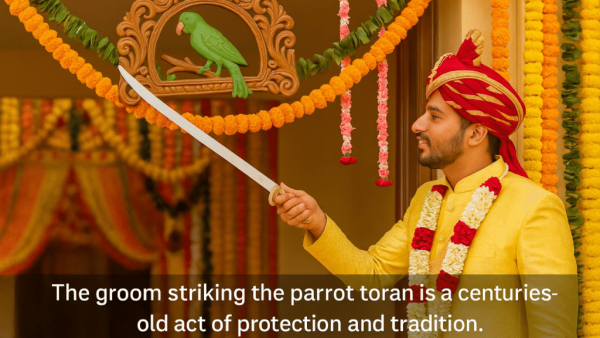
Mumbai: In many traditional Hindu weddings, particularly across North and Central India, there exists a centuries-old custom known as “toran marna” — the act of the groom striking a decorative arch (toran) with a sword before entering the bride’s home. This ritual, while visually striking, holds deep-rooted mythological and spiritual significance.
Often suspended above the entrance to the bride’s house, these torans are wooden or decorative hangings adorned with various symbols — most notably, a parrot. The presence of the parrot isn’t merely ornamental; it has ties to an ancient legend that explains the origins of this practice, and why grooms are expected to symbolically slay it with a sword before stepping through the doorway.
According to ancient beliefs, there once lived a demon named Toran, who had a peculiar and sinister habit. During wedding ceremonies, he would disguise himself as a parrot and sit above the door of the bride’s house. When the groom approached the entrance, the demon would enter his body and forcibly marry the bride himself, causing lifelong suffering for the newlyweds.
One day, a brave and intelligent prince became aware of this demonic trick. As he approached his bride’s home during their wedding, he spotted the parrot-shaped demon and swiftly struck it down with his sword. The wedding proceeded without disruption, and the ritual was born. Since then, striking the toran has symbolised the groom’s triumph over evil, ensuring protection for the couple’s future.
The parrot carved or depicted on the toran represents the same demon from the legend. It is usually made from wood and hung above the doorway, with the groom reenacting the slaying of the demon by striking it with a sword — a gesture that is both protective and symbolic.
Some traditions link the toran not just to demons but to the removal of obstacles and misfortunes. In these beliefs, the groom is seen as a form of Lord Shiva — the destroyer of evil. By performing this ritual, it is believed that Shiva himself, through the groom, removes all inauspicious energies from the path of the marriage.
Many such regional beliefs and stories continue to surround the toran marna ritual, keeping it alive across generations. While it may appear as just another ceremonial gesture to outsiders, for those who practise it, the toran stands as a powerful symbol of protection, courage, and the sacred duty of preserving marital sanctity.
(Disclaimer: The information provided is based on traditional beliefs and religious texts. News9 Live does not endorse or validate these claims.)